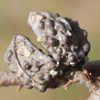Scrub Cypress-pine (Callitris verrucosa) is an evergreen coniferous tree in the Cupressaceae family. It is an obligate-seeder co-dominant within flammable semi-arid shrublands in southern Australia.
Callitris verrucosa is a small tree or shrub to 8 m high, usually multi-stemmed; branches erect. The leaves are 2–4 mm long green or grey-green and scale-like, except young seedlings, where they are needle-like, dorsal surface rounded.
The male cones are small, 3-6 mm long, and are clustered at the tips of branches. The female cones start out similarly inconspicuous, maturing in 18-20 months to 1-3 cm long and wide, globular to ovoid. Female cones solitary or grouped on stout, often clustered fruiting branches. The cone scales 6, thick, usually finely regularly warted, united below and forming a thick cone base, not spreading widely after opening. The cones can stay closed for years on the tree and they only pop open after the heat of a bush fire scorches them. The seeds are then released from the pods and start sprouting into saplings on the newly cleared area on the burnt ground. The seeds, 6 – 12 on each scale, chestnut to dark brown. Their body is 2.5-6 mm long. 1.5-3 mm wide with nearly two equal wings slightly longer than the body sometimes with a third wing.
The wood of cypress-pines is light, soft and aromatic. It can be easily split and resists decay, cypress-pine also is rot and termite resistant. It was these qualities that made it so popular for making furniture, indoor and outdoor paneling, and fence posts.
Scrub Cypress-pine grows in small clumps or isolated trees, chiefly on arid sandy soils in the western districts; New South Wales, Victoria, and South Australia. It is frost tolerant, drought tolerant. It is occasionally planted as ornamental trees, but their use is restricted by the high risks imposed by their very high flammability. In Israel it was planted in hillside water catchments in the Northern and Central Negev desert.
The seeds from the young cones are a popular food for Pink Cockatoos.
There are 15 species in the genus, of which 13 are native to Australia and the other two from New Caledonia.
Written by Amram Eshel






